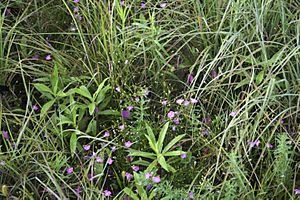Sandplain gerardia facts for kids
Quick facts for kids Sandplain gerardia |
|
|---|---|
 |
|
| Conservation status | |
| Scientific classification | |
| Genus: |
Agalinis
|
| Species: |
acuta
|
The Sandplain Gerardia (Agalinis acuta) is a special plant. It is also called the sandplain false foxglove. This plant grows for only one year. It is a hemiparasitic plant, which means it gets some of its food from other plants.
You can find this plant in the eastern United States. It grows naturally in Maryland, Massachusetts, Rhode Island, Connecticut, and Long Island, New York. The Sandplain Gerardia is one of about 70 different types of plants in the Agalinis group.
Contents
About the Sandplain Gerardia
The Sandplain Gerardia is a unique plant. Scientists have studied its DNA to understand its family tree. It belongs to the Orobanchaceae plant family. Some scientists now think Agalinis acuta might be a type of Agalinis decemloba.
Why This Plant Needs Help
In 1987, the United States government listed Agalinis acuta as an endangered species. This means it gets special protection on public lands. Plants become endangered for many reasons. For the Sandplain Gerardia, some threats include losing its home. People building new things can destroy its habitat. Also, sometimes plants are collected too much for study or sale.
What the Sandplain Gerardia Looks Like
This plant is an annual herb, meaning it lives for only one growing season. It can grow to be about 35 to 40 centimeters tall. That's about the length of a ruler and a half!
Leaves and Flowers
The leaves of the Sandplain Gerardia are long and thin. They can be up to 2.5 centimeters long and only one millimeter wide. The flowers grow on small stems called pedicels. These stems are about one or two centimeters long.
Each flower has a fuzzy, cup-like base called a calyx. The flower itself is a tube shape, about 1.3 centimeters long. It has rounded, notched petals. The flowers are pink with a white throat that has red spots. These pretty flowers bloom in late summer and early fall. Each flower only lasts for about one day, sometimes even less. The flowers can pollinate themselves.
Where the Sandplain Gerardia Lives
This plant likes sandy areas near the coast. It grows in dry, poor soils. You can often find it in sandplain grasslands. It also grows in open spots within pine forests.
Its Favorite Places
The Sandplain Gerardia grows best in places that have been disturbed. This means areas where other plants have been cleared away. For example, it thrives where animals have grazed or where there have been fires. These events help clear the ground, giving the plant space to grow. Some populations even grow in cemeteries that are regularly cared for.
Protecting the Sandplain Gerardia
There are about 22 or 23 groups of these plants. The number of plants can change each year. The biggest threat to the Sandplain Gerardia is losing its home. New buildings and changes to its habitat can harm it.
How We Help
This plant needs open, clear ground to grow. It does not do well if too many leaves or other plants pile up. It also struggles if trees grow tall and create too much shade. To help some populations, people let sheep graze in their habitat. The sheep eat other plants, which helps keep the ground open for the Sandplain Gerardia.


